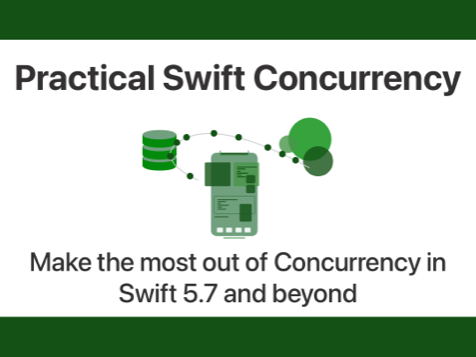In last week’s post, I demonstrated how you can use a task group in Swift to concurrently run multiple tasks that produce the same output. This is useful when you’re loading a bunch of images, or in any other case where you have a potentially undefined number of tasks to run, as long as you […]
Read post
Subscribe to my newsletter and never miss a post
Learn more about Swift
With Apple’s overhaul of how concurrency will work in Swift 5.5 and newer, we need to learn a lot of things from scratch. While we might have used DispatchQueue.async or other mechanisms to kick off multiple asynchronous tasks in the past, we shouldn’t use these older concurrency tools in Swift’s new concurrency model. Luckily, Swift […]
Read postThis post applies to the version of SwiftUI that shipped with iOS 15, also known as Swift 3. To learn how you can present a bottom sheet on iOS 16 and newer, take a look at this post. With iOS 15, Apple introduced the ability to easily implement a bottom sheet with UISheetPresentationController in UIKit. […]
Read postPresenting a bottom sheet in UIKit with UISheetPresentationController
Published on: June 30, 2021We’ve seen bottom sheets in Apple’s apps for a while now, and plenty of apps have followed this pattern. If you’re not sure what I mean, it’s the kind of sheet that takes up just a part of the screen and can be swiped upwards to take up the whole screen or downwards to be […]
Read postWhat’s the difference between a singleton and a shared instance in Swift?
Published on: April 19, 2021A common pattern on iOS, and in Swift, is to define an instance of an object that you can access from any place in your app. Common examples are URLSession.shared, FileManager.default, and UserDefaults.standard. These objects can all be considered shared instances, or globally available instances. Defining a shared instance is commonly done as follows: struct […]
Read postVirtually every modern application needs some way to retrieve, and use, data from a remote source. This data is commonly fetched by making a network request to a webserver that returns data in a JSON format. When you’re working with Javascript, this JSON data can be easily decoded into a Javascript object. Javascript doesn’t have […]
Read post10 things iOS developers should focus on in 2021
Published on: January 4, 2021I know. This is a clickbaity title. And yes, I know that this list is not relevant for everybody. I know that not every iOS developer has to learn everything on this list. That said, this list is a list of technologies and skills that I think are either already important, or becoming increasingly important […]
Read postBuilding a simple remote configuration loader for your apps
Published on: October 26, 2020Remote configuration is a common practice in almost every app I have worked on. Sometimes these configurations can be large and the implications of a configuration change can be far-reaching while other times a configuration is used to change the number of items shown in a list, or to enable or disable certain features. You […]
Read postAs a developer, you’ll come across the term "deadlock" sooner or later. When you do, it’s usually pretty clear that a deadlock is bad (the name alone implies this) and if you’ve experienced one in your code, you’ll know that your application crashes with EXC_BAD_INSTRUCTION (code=EXC_I386_INVOP, subcode=0x0) when a deadlock occurs. A few weeks ago, […]
Read postWhen writing iOS apps, we regularly run into code that is asynchronous. Sometimes you know you’re writing something that will run asynchronously and other times you’re passing a completion handler to code that may or may not run asynchronously on a different dispatch queue. If you’re familiar with using DispatchQueue.main, you have probably written code […]
Read postExpand your learning with my books

Learn everything you need to know about Swift Concurrency and how you can use it in your projects with Practical Swift Concurrency. It contains:
- Eleven chapters worth of content.
- Sample projects that use the code shown in the chapters.
- Free updates for future iOS versions.
The book is available as a digital download for just $39.99!
Learn more